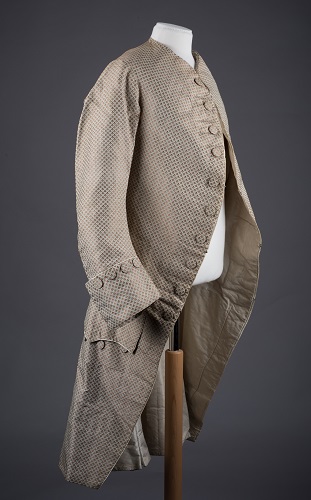Silk, Sleeves, and Sweat – Part 1: Georgian Menswear in the York Castle Museum Collection – by Dr M Faye Prior, Collections Facilitator (History)
York Castle Museum’s History Team are excited to tell you about the latest historic clothes to come into our collection – a wonderful selection of Georgian menswear. This is the first of three blog posts about these fascinating garments by Dr M Faye Prior, our Collections Facilitator (History).
We’re especially happy to welcome menswear into our collection because it doesn’t tend to survive as well as women’s clothing. There are several reasons for this.
Before the 20th century, clothes generally made their way down the social scale from richer to poorer, being given as gifts or sold, until they had been used by so many people they were completely worn out. This is especially true for menswear.
The second reason is that men don’t seem to have kept clothes as mementos as often as women did.
And the third reason is that when people started collecting historic costume, they generally focused on womenswear. This could be because historic women’s fashions tended to be less practical, and often gave women’s bodies dramatic shapes that completely changed their natural silhouettes.
This made historic women’s clothes a curiosity, piquing peoples’ interest, while men’s clothes weren’t thought of in quite the same way. This is why UK museums often have far better collections of women’s clothing than men’s, something that’s certainly true of the holdings here at York Castle Museum.
So, we were excited to be offered 18th century menswear, even more so when we saw the impressive variety of garments and their designs and decoration.
The most dramatic outfit of the new donation is a silk three piece suit dating from around 1765-75, which consists of a frock coat – so called because of its large pleated skirts, pictured below – a waistcoat and a pair of breeches, all made from the same silk fabric. Take a look at the gallery at the bottom of the page for more images.

Silk was the most expensive textile in the 18th century, and could be woven to produce many different effects. The technique used here is a kind of brocade – more expensive than plain silk – and the fabric has been woven with a repeating pattern of tiny flowers. Floral designs weren’t then thought of as feminine, and flowers were very popular in menswear.
As well as being the most expensive textile, silk was the hardest to clean. A silk suit like this was a real show of wealth – not only because of the cost of the materials and making, but because it showed you could employ servants to keep it looking its best.
The suit has clearly been worn. Spot the perspiration stains under the arms of the coat and waistcoat. In the 18th century, men’s underwear consisted of a shirt and a pair of breech liners, usually made of linen. This layer could be washed very often.
Wealthy people tried not to get perspiration or any dirt onto their outer clothes because it was impossible to wash them – they were instead spot cleaned by servants. The stains on this suit might indicate that it was worn as a fancy dress outfit in the 19th or early 20th century; fancy dress was especially popular at that time, and many people used historic clothing they had inherited or bought.
Visit the blog again soon to see some of the wonderful waistcoats from this unique collection. You can also discover more about fashion through the century’s at York Castle Museum’s exhibition, ‘Shaping the Body’. Click here to find out more.

